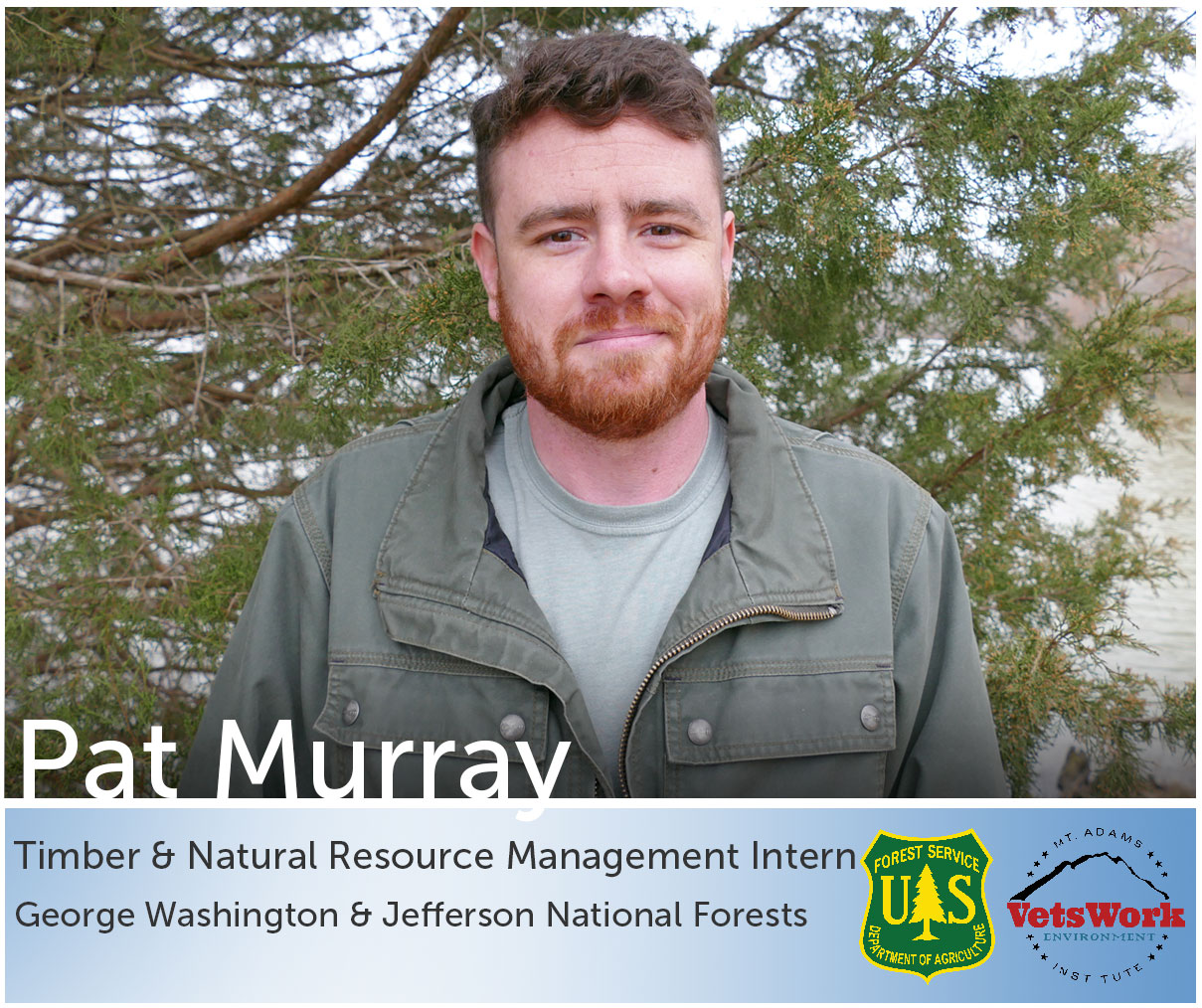
There are a few easy ways for an outsider to know when spring has begun in Rockbridge County. The turkeys are out, as are the soon to be hunters, Morel mushrooms will begin to appear around the poplar trees, and country roads will become clogged with trout anglers. In modern day western Virginia, trout is a much bigger deal than I had ever imagined. As someone who grew up in the plains of North Carolina, where fishing was not too common, it was amazing to see the shear number of people who would spend their day fishing for trout in federal waters stocked by the state.
My name is Pat Murray and I am the Mt. Adams Institute VetsWork intern on the Glenwood Pedlar District of the George Washington and Jefferson National Forests. I was raised in a rapidly developing area of North Carolina, just south of Raleigh, and spent much of my time as a youth outside in the woods. However, I have never had much knowledge of the outdoors, save for some basic survival skills and orienteering skill that I received during my time in the United States Marine Corps. It has been a wonderful experience so far, learning so much about nature and more specifically the natural areas in Appalachia. To me one of the more fascinating elements of my internship so far has been watching the local culture that has evolved around fishing state stocked trout waters. The concept and obsession for many people of fishing stocked waters has been a point of internal conflict for me; on one hand, many people catch and harvest the trout for meals and are participating in a ritual that their families have participated in for generations. On the other hand, the artificial populations are just that, artificial, and certain species of stocked trout are not native to Virginia streams. This has prompted me to do a bit of researching into the history of trout stocking in the state.
While most of the work and management is controlled by the state of Virginia, many of the waters stocked are on lands managed by the USFS. The Forest Service assists the state by maintaining the roads, monitoring the health of stocked waters and native populations, and also holding events centered on the promotion of trout fishing.
The history of stocking fish in America goes back to the 1800’s. Most of this was done by private organizations to mask over fishing and decline in native fish habitat and populations due to unrestricted logging and growth of industry. It was not until the early 1920’s that Virginia, through the Virginia Department of Game and Inland Fisheries (established in 1903), began to regulate stocking of fish in it’s waters and also buying trout hatcheries and stocking waters themselves. Trout was found to be one of the easiest fishes to raise in a hatchery and of the species stocked in Virginia, one was already native to the area. The three species stocked in Virginia are the Rainbow, Brown, and Brook Trout, with the Brook Trout being the native species. While stocked fish will compete with naturally occurring populations, they are not considered invasive as the stocked fish are rendered sterile and can only be introduced by stocking. The practice of stocking and its effectiveness is up for debate across the state, with many people upset with the practice and others wanting a more robust program to increase the number of fish stocked. Records and numbers of released fish do not exist before 2010. In the period between 2010 and 2015 an average of over 1 million fish were stocked annually.
Culturally speaking, from the early 1930’s to 1995, trout was fished on a seasonal basis and was not year round. Opening day of trout season was a much-anticipated day and often brought large numbers of people to stocked fishing waters. This caused conflict due to the numbers of anglers present at the same location competing for the same stock. Since that time, the state has moved to a year round trout season, which has lead to a more stable and manageable production of fish at local hatcheries. This decision has also been controversial, some people prefer the tradition of an opening day, while others did not enjoy the large crowds and increase in traffic at local streams, not to mention the competition. This has resulted in the creation of a Heritage Day event, held close to the former opening day, which leads to the same consequences and complaints. This event also leads to an increased volume of litter and human waste in natural areas. Certain waters are closed during certain periods of the year, even though they are stocked during that time, this has lead to a good deal of poaching. In addition, it is not common to find CPO’s checking for the appropriate license or enforcing creel limits. In my opinion, there is not an effective effort to deter any of these crimes, as there is simply too much area to cover with too few officers to enforce regulations. There is also the cultural phenomenon of retirees following stocking trucks from the hatchery to the water to be stocked and they immediately begin fishing the waters. Many feel that this is unfair and depletes the waters much too quickly. The state currently has no regulation or law against this practice, much to the chagrin of working individuals who do not have as easy of a time catching trout as others.
But there are also positives to this practice. It encourages the use of public lands and allows for the passing on of traditions between generations. It also provides another opportunity for people to catch and harvest their own foods, further deepening the connection between man and the natural environment. The revenue generated from the sale of licenses and equipment has provided the money for the project to continue, created jobs, and drives sales of equipment for all sorts of outdoors equipment.
At what point do we disregard tradition in favor of returning to the natural order? This is also a question that the state of Virginia and the USFS must continually ask themselves and the communities that they serve. Many streams that have historically been the home of the Brook Trout are still recovering from the effects of man from over a century ago and if natural populations were left augmented by stocked fish, they would likely be depleted in short order because of over fishing and continued destruction of habitat (whether cause by man or by nature).
For me, I’m still undecided. While part of me believes that we should let nature run its course and minimize the impacts of humans, I still enjoy a local caught trout filleted and fried with a side of fries. I believe for the time being we have hit a happy middle ground with the ongoing conversation and efforts of State, Federal, private groups and the community to ensure that a tradition long established in Virginia continues with minimal negative impact on the Appalachia.
If you are interested in looking into trout stocking in Virginia or in your local area, these documents may be a great place to start.
- www.dgif.virginia.gov/wp-content/uploads/stocked-trout-management-plan-final.pdf
- www.researchgate.net/profile/Amanda_Hyman/publication/324068037_THE_VIRGINIA_STOCKED-TROUT_PROGRAM_AN_EVALUATION_OF_ANGLERS_AND_THEIR_CATCH/links/5abbcdf045851584fa6d9c93/THE-VIRGINIA-STOCKED-TROUT-PROGRAM-AN-EVALUATION-OF-ANGLERS-AND-THEIR-CATCH.pdf

